I.
“History and past memories, especially recent past memories, were rarely topics of family conversation when I was growing up during the 1950s and 1960s. World War II, in particular, was off limits for discussion, and might as well have taken place in the Middle Ages instead of a mere decade or so before,” recalls historian John Heitman. In 1994, Heitman began investigating how his father Alfred had come to be interned in 1942 as a “dangerous pro-Nazi Sympathizer.” According to Heitmann’s research, his father’s and eventually also his mother Caroline’s (in her case voluntary) internment resulted from the “unconstitutional investigative methodology of the government” (Heitmann), which relied on weak evidence and statements by informants who probably wanted to save themselves and their families. That the conjectures in Heitmann’s case were unsubstantiated was later proven by an FBI investigation, including the fact, for example, that Heitmann did not own a camera and could never have taken the many photographs attributed to him. Until his release in the summer of 1945 Heitmann was first interned at Ellis Island, then Fort Meade, MD, Camp Forrest, TN, Fort Lincoln, ND, and Seagoville, TX. The institutionalization of local hearing boards—and not regular courts—to individually investigate the cases only seemingly provided fairness to the internment process. In Heitmann’s case, he had claimed to be a conscientious objector, and although the draft board had ruled in his favor, he was continuously asked during the hearings why he was unwilling to fight against Germany. Furthermore, a document of allegiance to the Third Reich signed by a certain Rudolf Heitmann was wrongfully attributed to him. While Alfred Heitmann was released after three years of incarceration and lived a productive life until 1983, others who also experienced internment, exchange or repatriation during World War II were not that lucky.
The agenda of the essays in this special issue is to pay attention to historical debts of World War II by examining how contradictory and more complicated stories about World War II need to be told to record the complexity of lived experience. Many of the stories—like this one about the German American experience of internment—do not have the potential to add to the unifying narrative of the “Good War” (cf. Terkel); they rather resist processes of mythmaking. Eventually, these stories and the commemorative practices they triggered will need to become part of further documentary efforts, so that a celebratory tale of the great American victory cannot easily be appropriated for a justification of wars or curtailments of civil liberties.
I am certainly not the first to point out that World War II was not simply “The Good War.” Many scholars have challenged Tom Brokaw’s “greatest generation” epithet (Brokaw, The Greatest Generation; Brokaw, The Greatest Generation Speaks; Brokaw, An Album of Memories), among them, Paul Fussell (161), Joseph J. Ellis (13), and Arthur Schlesinger, Jr., who admits that “my generation, the generation that fought World War II, wasn’t, despite Tom Brokaw’s generous phrase, the ‘greatest generation’” (22). John Morton Blum and Michael C. C. Adams have questioned the ‘goodness’ of the war even before Brokaw’s phrase took hold (Blum; Adams). Charles P. Pierce has pointed out that the “beatification of the Greatest Generation” has taken place because “some vague unpaid cultural debt has been conjured out of a kind of sentimental historicity” (Pierce 74). John Dower was one of the first scholars to identify World War II as a race war at a time when the label of “The Good War” was just beginning to be circulated (Oostdijk 12). Dower defines it as a war driven by “raw prejudices and […] fueled by racial pride, arrogance, and rage on many sides” (Dower 4).
II.
In fact, racist anti-Japanese sentiment amplified by the fear after the Japanese attack on Pearl Harbor resulted in the U.S. government’s authorization of extensive searches of the homes of Japanese immigrants and Japanese Americans, wrongly suspecting them of committing acts of sabotage, espionage, or treason. In fact, no evidence for any such activities was ever found, and it has been documented by scholars such as Roger Daniels, Sandra Taylor, and Harry H. L. Kitano and acknowledged by the Commission on Wartime Relocation and Internment of Civilians (CWRIC) that racist as well as economic reasons played major roles in government policy (Daniels, Taylor, and Kitano). In the time after Pearl Harbor, especially respected elders, community leaders, and heads of households were detained by the Federal Bureau of Investigation (FBI) and imprisoned in Department of Justice (DOJ) Internment Camps. President Franklin Delano Roosevelt’s signing of Executive Order 9066 on February 19, 1942, instigated the forced removal and incarceration of 120,000 Japanese Americans, two thirds of whom were U.S. citizens by birth. They were only given a few days to leave their homes and report to local pick-up areas from where they were taken to “assembly centers” or directly to designated “relocation centers.” Families were identified by tagged numbers rather than their names. Allowed to take with them “only what they could carry” (Inada), most had to sell their homes and businesses and other property they had been able to acquire despite restrictive land laws (e.g., in California) for unreasonably low prices.
The internment represents the greatest violation of civil liberties in American history. The injustice of the incarceration was not acknowledged by Congress until the 1980s, after Japanese American groups, organizations and individuals had pressed for a formal apology and for redress. In 1988, the Civil Liberties Act awarded the 60,000 former internees still living $1.25 billion in reparations. Two years later, in October 1990, President George H. W. Bush signed a formal apology as well as the first checks made out to members of the Japanese American community who had been incarcerated. The Civil Liberties Public Education Fund (CLPEF), established under the Civil Liberties Act, was mandated to finance projects that would educate the public about internment, sponsor research activities and award national fellowships. As a result, visibility and knowledge of the internment began to increase in the 1990s, and the ground was prepared for the recognition and discussion of Japanese American experiences during World War II (see Gessner 32).
Besides Japanese Americans, Japanese-Latin Americans, German Americans, German-Latin Americans, Italian Americans, and Italian-Latin Americans were also interned during World War II. Without wanting to diminish the suffering of Japanese Americans, my argument acknowledges the question of scale yet wants to highlight the fact that the internment of the groups listed above is much less known. They were not included as recipients of compensation in the Civil Liberties Act of 1988.1
President Roosevelt’s Executive Order 9066 was geared against all enemy aliens, yet people of German or Italian descent were not as systematically removed to internment camps as Japanese Americans were. The population of Germans and German Americans, which represented the biggest single ethnic group in the United States, was far too large for such a program,2 and racist sentiments did not play the same role as in the case of Japanese Americans. However, Germans, (naturalized or U.S.-born) German Americans, Italians, and Italian Americans were detained under the Alien Enemies Act (1798). Similar to the arrests of respected elders in the Japanese American community, many heads of German families and active presiding members of German clubs were arrested shortly after the attacks on Pearl Harbor.3 While some were quickly released, many remained interned—often for the duration of the war and up until 1948. Internees were frequently transferred between detention facilities, such as Ellis Island Detention Station, New York, or Sharp Park Detention Station, California. The majority was eventually interned in one of the eight main Department of Justice camps administered by the Immigration and Naturalization Service (INS): Fort Lincoln Internment Camp, North Dakota; Kenedy Detention Station, Texas; Fort Stanton Internment Camp and Santa Fe Internment Camp in New Mexico; Fort Missoula Internment Camp, Montana; and Kooskia Internment Camp, Idaho (which had no German but Japanese internees). Two camps in Texas became known as Family Internment Camps because women and families were equally admitted: Seagoville Detention Station and Crystal City Internment Camp (“World War II Enemy Alien Control Program Overview”).
The internment program also had a transnational component. On the basis of hemispheric security, the United States demanded Latin American countries to evict Germans, Japanese, and Italians, whom the FBI suspected of subversive activities (“World War II Enemy Alien Control Program Overview”). The official terminology was that the United States “recommended” the eviction of Japanese, German, and Italian nationals. There was a clear intention of using the evicted people for planned hostage exchanges. Some even referred to the Unites States as going “hostage shopping” in Latin America, particularly Peru (Peek et al.). Fifteen Latin American countries responded and 6,609 people of Japanese, German, and Italian descent were brought to the United States. The 6,609 split up into 4,058 German-Latin Americans, 2,264 Japanese-Latin Americans, and 287 Italian-Latin Americans. INS camps were also located in Mexico, Cuba, and Puerto Rico. In the United States the evicted aliens were detained in the Department of Justice’s Immigration and Naturalization Service (INS) camps (Donald). Altogether, 11,5004 Germans and German Americans from the Unites States and 4,000 Germans from Latin America were initially detained and about 6,000 remained interned fort the duration of the war and some until 1948 (Sundquist; Krammer; Fox). The number of Italian internees was smaller and only about 600 remained interned for more than two years.5 Many internees chose or were forced to repatriate to the country of their ancestry.6 They were accompanied by their American spouses and children.
III.
Crystal City was one of the largest Department of Justice internment camps and one that could accommodate families. Today, Crystal City bears several layers of memory, only one of which is connected to its internment camp past. A (by now) retro-monument on Main Street, which has its roots in the 1930s, announces the city’s status as Spinach Capital. In the 1960s Crystal City witnessed successful Mexican American revolts and became the birthplace of the Texas Vietnam Veterans Memorial Highway (U.S. Route 83). While signposts mark the highway, only overgrown concrete foundations are left of what used to be the home for close to 5,000 people in the 1940s. At Crystal City Internment Camp, 4,751 people were confined between mid-1942 and 1945; 153 children born in the camp are included in this figure (see fig. 1). Originally the camp, which had been a migrant labor camp before the war, was intended for people of Japanese ancestry and their immediate families. Yet, the first internees to arrive on December 12, 1942, were German Americans and German “enemy aliens.” The first group of German-Latin Americans arrived from Costa Rica on February 12, 1943, and the first Japanese Americans on March 17, 1943. Eventually, Japanese and Japanese-Latin Americans became the largest group at Crystal City, making up more than two thirds of the camp population. Germans and Italians—both from the United States and Latin America—also remained interned there. Because of problems concerning forced repatriation of particularly Japanese Latin American internees after the official end of the war the camp was not closed until 1948 and was then completely dismantled.
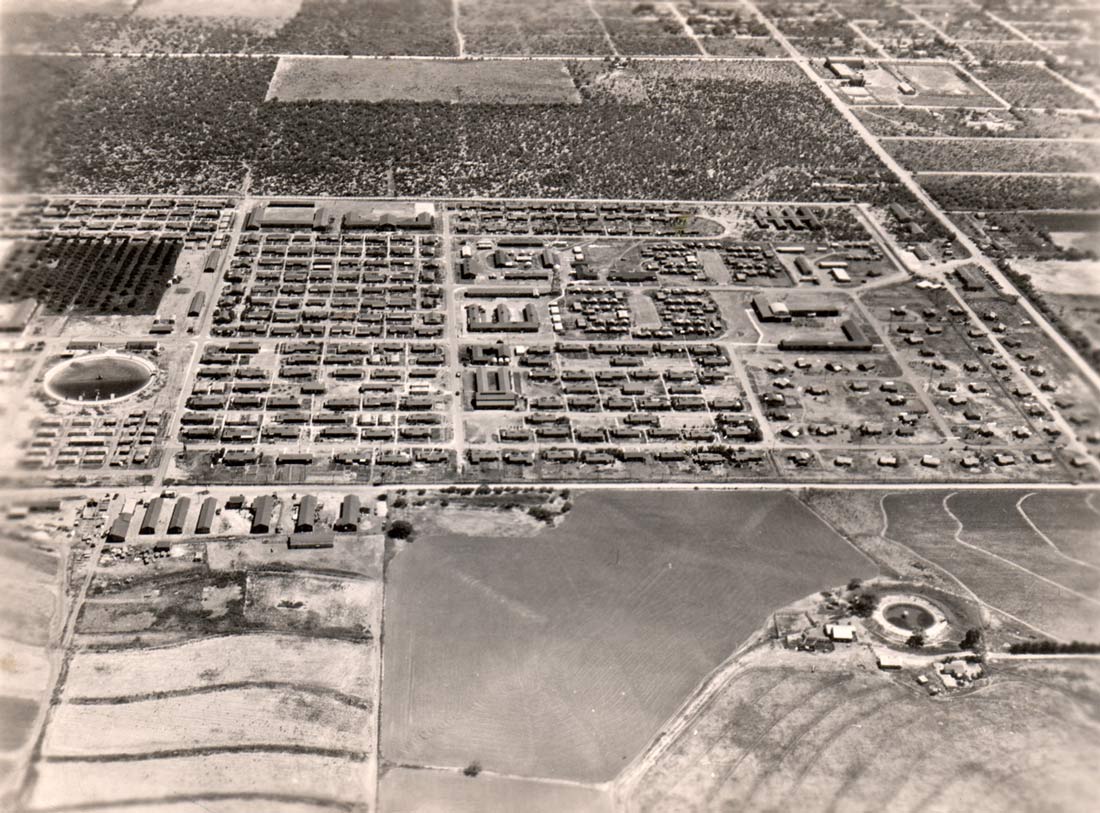
Licensed under a Creative Commons Attribution NonCommercial-NoDerivs 2.0 Generic License. No changes made.
Part of Crystal City’s national significance is due to its specific establishment as a family internment camp. After the detention of many fathers, the INS heeded to the wish of often naturalized or American-born wives and children to be reunited with their husbands and fathers and voluntarily join them in internment (“World War II Enemy Alien Control Program Overview”). Yet, although they voluntarily entered the camp, they could not voluntarily leave it. The camp was surrounded by a 10-foot high barbed wire fence and had six guard towers. Armed guards patrolled the fence line and the inner sections of the camp.7 Although no internee had to work against their will (in fulfillment of the Third Geneva Convention), most internees took on jobs as store clerks, hospital staff, librarians, laundry workers, shoe repairmen, janitors, barbers, and beauticians, or worked in the camp’s fruit and vegetable gardens and adjacent agricultural fields. They could earn 10 cents per hour up to a maximum of $4 per week. For the children, three types of schools were established: the American (called Federal) School, the Japanese School, and the German School. The latter two especially served the purpose to prepare future voluntary and non-voluntary repatriates for life in their ancestral home land (“Crystal City Family Internment Camp”).
The story of the Eiserloh family, recorded as part of the German American Internee Coalition website, is an example of a repatriated and exchanged family (“The Eiserloh Family Story”). Mathias and Johanna Eiserloh emigrated to the United States from Germany (Idstein, Hesse) in 1922. They endured many hardships, but were able to build their own home outside of Cleveland, Ohio. Their three older children were born between 1930 and 1941, their youngest in 1945. All of them were U.S. citizens by birth, whereas the parents had never pursued their plan to apply for citizenship. Shortly after the attack on Pearl Harbor, Mathias was arrested by FBI agents because of his membership in a German social club. Due to Mathias’ internment, all savings were frozen and the family lacked any source of income. Johanna had to sell the family’s home. In 1943 she and the three children joined Mathias in the Crystal City Internment Camp. Pressurized, the family agreed to repatriate to Germany. In January 1945, they boarded the S.S. Gripsholm at New York Harbor under a wartime exchange program between Germany and the United States, which released U.S. citizens held in Germany in exchange for “Germans” sent back from the United States (see fig. 2). With several hundred repatriates they later disembarked at Marseille and were transported to Bregenz at the Swiss-Austrian (then Swiss-German) border for the exchange. Crossing war-torn Germany they made it to their former hometown where they felt most unwelcome. Mathias was mistreated by local SS members and arrested by the Gestapo as a suspected American spy. In 1947, the two eldest children, Ingrid and Lothar (12 and 17) were allowed to repatriate to the United States. Their parents and the two younger children followed in 1955.
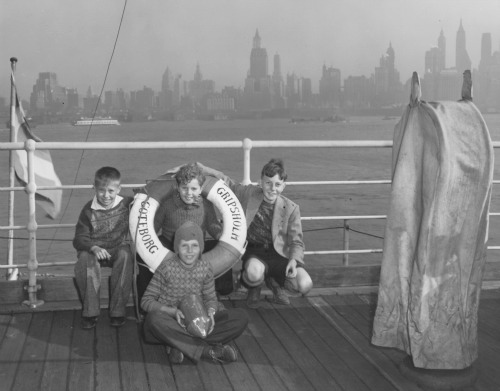
National Archives Record Administration RG 59, Box 1, Folder 5.
Young Ingrid Eiserloh’s story has only recently been introduced to a much larger audience in Jan Jarboe Russell’s The Train to Crystal City (2015). For her book, Russell has tapped the memory of about fifty former Crystal City internees, the diary of Earl G. Harrison, who was in charge of overseeing Crystal City as commissioner of the Immigration and Naturalization Service, and the personnel file of former internment camp officer Joseph O’Rourke (Russell, Train; Maslin). While certainly adding an important facet to the American narrative of World War II, Russell’s third-person narration never achieves the immediacy and authenticity to be found in the accounts and oral history recordings of the German American Internee Coalition, the Densho project, and the Texas Historical Commission. There, we hear from Eberhard Fuhr about his internment at age 17 that “[he] did over 4 years of time for being German” (Fuhr, “My Internment”); we also hear the voices of Heide Gurcke Donald, a German-Costa Rican whose family was arrested and deported by the Costa Rican government to Crystal City; U.S. citizen Arthur D. Jacobs,8 who was held at Crystal City with his family during the war and was exchanged and repatriated to Germany; Bessie Masuda, a Japanese American internee from California, whose family was reunited with her father at Crystal City; and Audrey Moonyeen Neugebauer Thornton, who was born in London, England, to a British mother and a German father, arrested in Costa Rica and deported to Crystal City with her family (“Crystal City Family Internment Camp”).
IV.
The Crystal City internment camp was dismantled in 1948 and was eventually replaced by three schools and adjacent athletic fields, a small airport, city social service buildings, and a low-income housing project (“Crystal City [Detention Facility]”). Responding to the fact that very few original foundations remain, former internee Werner Ulrich has recreated a map of Crystal City, which identifies the dwellings where each family resided. With details provided by other former internees, family members of former camp officials, and the National Archives and Records Administration, he thus created an important document of spatial commemoration (“Crystal City” 5). In 1985, a marker sponsored by the children and friends of former detainees in cooperation with the municipality of Crystal City and the school district was placed at the site (see fig. 3). It commemorates the Japanese and Japanese Americans arbitrarily incarcerated in what is correctly called a “concentration camp” on the marker. On November 8–10, 2002—sixty years after the internment camp was opened—the first multi-ethnic national reunion of former internees was held at Crystal City. Chiefly organized by Richard G. Santos from the Zavala County Historical Commission, it was also a political event. The City Council, the Zavala County’s Commissioner’s Court, and Texas State Representative Tracy King officially welcomed the former internees and their families and joined them in their pledge of “Justice for All” (City Council). About 150 German and Japanese Peruvian internee families attended the meeting, many of which returned to the Crystal City for the first time. In a letter to the editor of the Zavala County Sentinel Karen Ebel, daughter of former internee Max Ebel, and Eberhard Fuhr point to the long if not currently ongoing silence about their camp experience that many of their fellow internees, including Fuhr’s older brother Julius, never broke (Fuhr, “Address at Crystal City Internment Camp Reunion 2002”). Eberhard Fuhr’s story is part of the German American Internee Coalition’s website and a couple of videos of Fuhr exist online documenting talks he delivered in public settings. As more and more oral histories were added in online databases in the early 2000s, BBC News in 2004 aired a feature on the “Lost Voices of Crystal City” detailing the story of Eric Gehrmann, who was first held in Costa Rica under an agreement with the U.S. government, then brought to Crystal City and was eventually deported to wartime Germany, a country he had never visited (“The Lost Voices of Crystal City”).
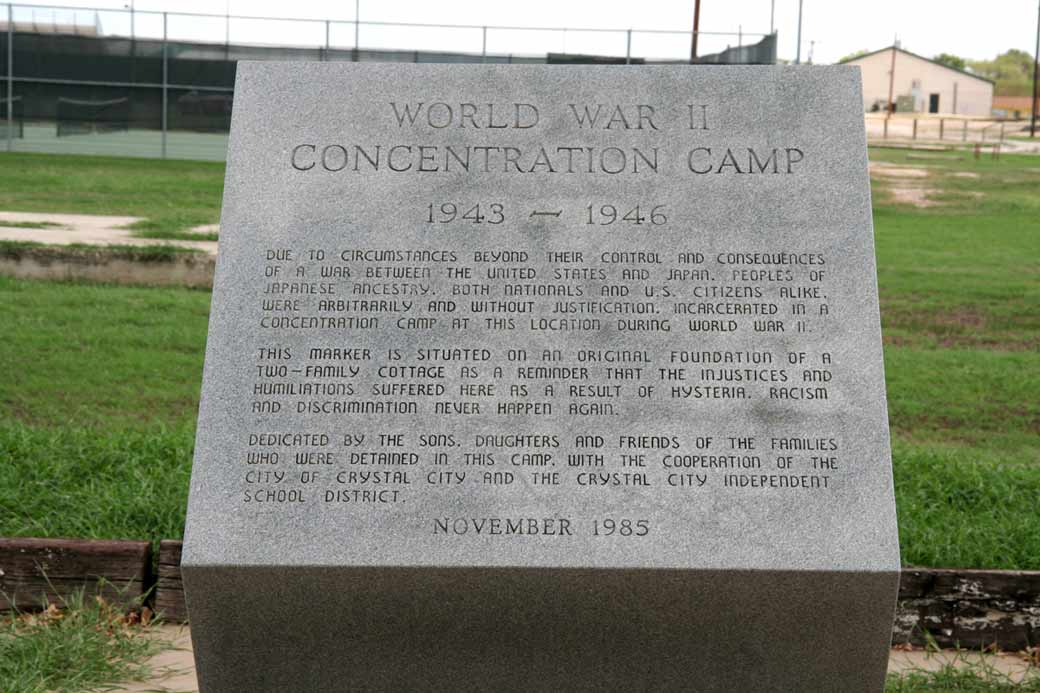
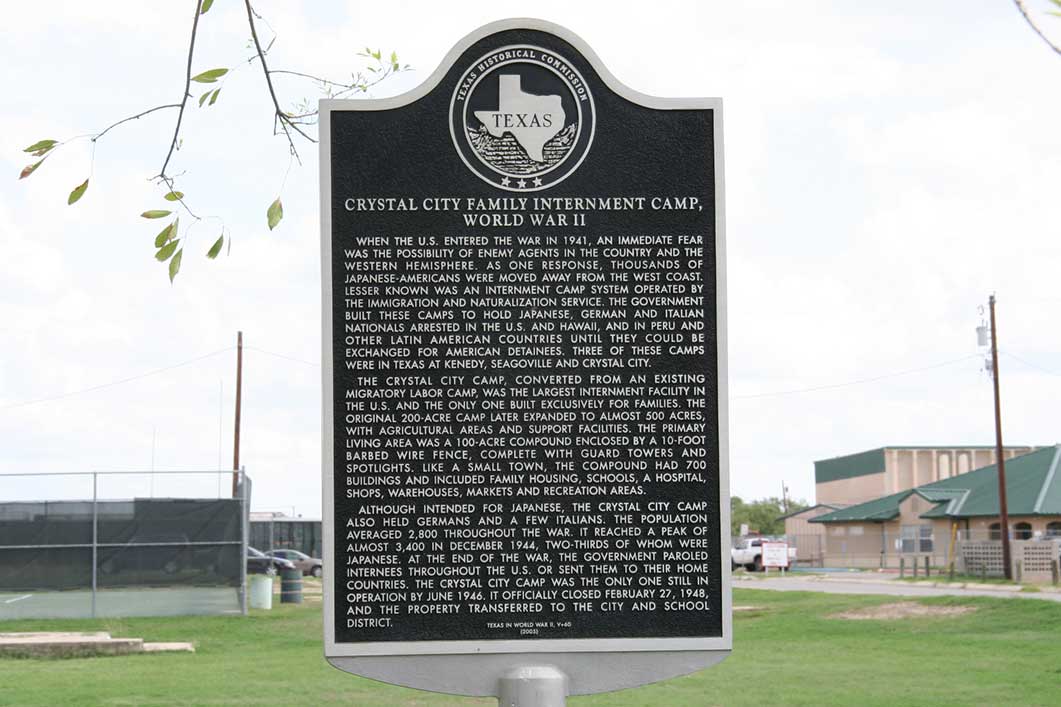
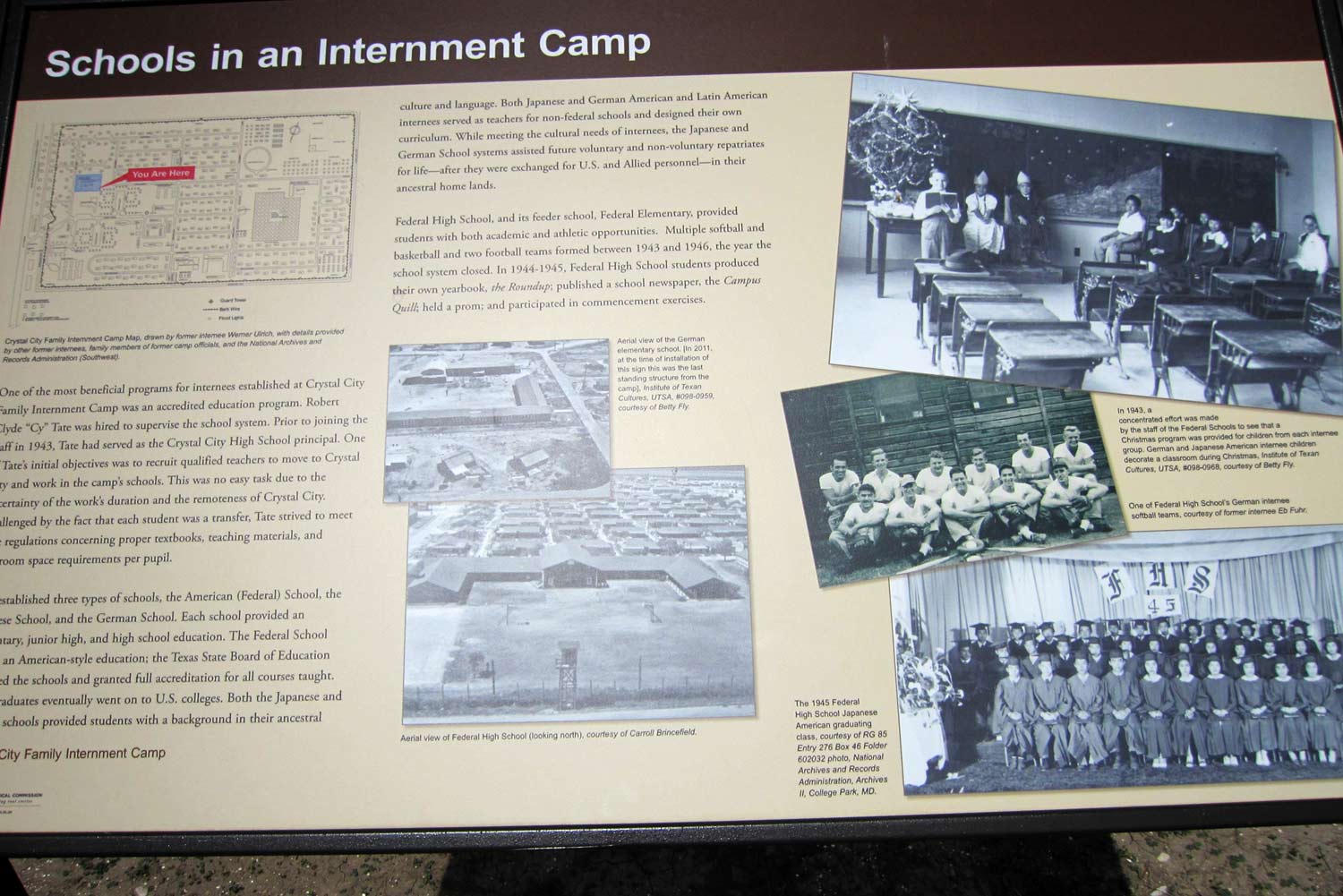
Photo courtesy of Linda Harms Okazaki <http://lindasorchard.com/2012/09/>.
A Texas historical marker to the Crystal City Family Internment Camp and its specific groups of internees was placed at the site in 2007 (see fig. 4). It lists all the interned groups. Since November 2011, eight panels have been marking an interpretive trail at the former confinement site (see fig. 5). The construction and dedication of these panels and a smaller reunion of former internees were documented on the Texas Country Reporter, a weekly syndicated television program (Crystal City Internment Camp). As part of the “Texas in World War II” program, the Texas Historical Commission undertook archaeological excavations at the site in April 2013 in preparation for nominating the site for listing on the National Register of Historic Places.9 Historians of the commission have also conducted oral history interviews with internees from all three national backgrounds (including both U.S. citizens and “enemy aliens”) and also with U.S. citizens that worked at the camp or lived in Crystal City during World War II; they can be accessed through the website of the Texas Historical Commission (“Crystal City Family Internment Camp”).10 A Wartime Treatment Study Act that was introduced in 2001 to create an independent commission to review U.S. government policies directed against German and Italians during World War II in the United States and Latin America has not become a law although it was reintroduced several times.11
***
In order to prevent the misuse of a unifying war myth for an all too simple justification of wars and curtailment of civil liberties, we need to continue to take heed to the experiences and circumstances of multiple communities during World War II and also to their transnational implications. Besides the documentary markers and the archeological efforts of the Texas Historical Commission, the continued documentation of oral testimonies of former internees will benefit from an expansion of such interviews to be conducted in Japan and Germany. They would include those who voluntarily or involuntarily had to leave their adopted home country for their ancestral homelands. A comparative analysis of the four camp newspapers—the Crystal City Times (English), the Jiji Kai (Japanese), Los Andes (Spanish), Unter Uns, Das Lager, and Lager-Nachrichten (German)—might furthermore shed light on the camp’s rich cultural life.12 These efforts are crucial to preserve the many layers of memories that define Crystal City and other places like it. As historic sites invested with memories of confinement, these places rightfully challenge a liberatory version of the World War II narrative. They add an important facet to the diverse experiences and stories that scholars are still unearthing and analyzing 70 years after the end of the war.
Notes
2 According to the U.S. census of 1940, about 1,237,000 native Germans lived in the United States; 5 million persons had both parents born in Germany; and 6 million persons had at least one parent born in Germany (Kashima 1997, 289).
3 Presidential Proclamations 2525, 2526, and 2527 authorized the United States to detain allegedly potentially dangerous enemy aliens after the bombings of Pearl Harbor.
4 According to the Texas Historical Commission “[a]pproximately 11,507 German Americans were interned in the U.S. during the war, accounting for 36 percent of the total internments under the DOJ Alien Enemy Control Unit Program” (“Crystal City Family Internment Camp”).
5 1,521 Italian aliens were arrested by the FBI until June 1942 and about 250 remained interned for up to two years together with 287 Italian-Latin Americans (DiStasi). Most of the Italian American internees were released after Italy’s surrender on September 8, 1943.
6 Only a few pursued legal means to fight for due process, to avoid repatriation, and be released (“World War II Enemy Alien Control Program Overview”). By December 1945, approximately 1,260 Japanese Peruvians were exchanged out of Crystal City––600 to Hawaii and 660 to Japan––because Peru would not take them back after the war (“Crystal City Family Internment Camp”). By January 1945 “a total of 2,361 Americans caught behind enemy lines in Europe had been returned from Germany and Italy in excchange for 4,500 Germans and 124 Italians who had been interned in U.S. camps” (Russell, “Trade Off” 70).
7 There were no reported escape attempts, successful or otherwise (“Crystal City Family Internment Camp”).
8 Arthur D. Jacobs has also recorded his story in an autobiographical narrative: The Prison Called Hohenasperg: An American Boy Betrayed by His Government during World War II.
9 The survey was funded through a 2012 grant from the National Park Service’s Japanese American Confinement Sites Grant Program (“Crystal City Family Internment Camp”).
10 The University of Texas San Antonio Libraries holds at least 250 records pertaining to Crystal City in their digital Collections, mostly historical photographs as well as oral history interviews (“Crystal City”).
11 On August 3, 2001, Senators Russell Feingold (D–WI) and Charles Grassley (R–IA) introduced the European Americans and Refugees Wartime Treatment Study Act in the U.S. Senate. They were joined by Senator Ted Kennedy (D–MA) and Senator Joseph Lieberman (D–CT). The renamed Wartime Treatment Study Act was reintroduced several times, the fourth time in 2009. However, it was not voted on by the full House and did not become law. It has not been re-introduced since then.
12 A scanned version of 75 pages of several Crystal City German newspapers, including Unter Uns, Das Lager, and Lager-Nachrichten is available online (“Crystal City Camp Newspapers”).
Works Cited
Blum, John Morton. V Was for Victory: Politics and American Culture during World War II. New York: Harcourt Brace, 1976. Print.
Brokaw, Tom. An Album of Memories: Personal Histories from the Greatest Generation. New York: Random House, 2001. Print.
—. The Greatest Generation. New York: Random House, 1998. Print.
—. The Greatest Generation Speaks: Letters and Reflections. New York: Random House, 1999. Print.
City Council. “Resolution No. 02-13 of the City Council of the City of Crystal City, Texas.” Freedom of Information Times. N.p., 28 Oct. 2002. Web. 10 Feb. 2015.
“Crystal City Camp Newspapers.” The Freedom of Information Times. N.p., n.d. Web. 10 Feb. 2015. <http://www.foitimes.com/index_files/Internee_Newspapers.htm>.
“Crystal City (Detention Facility).” Densho Encyclopedia. N.p., 22 May 2014. Web. 10 Feb. 2015.
“Crystal City Family Internment Camp.” Texas Historical Commission. N.p., 2015. Web. 9 Feb. 2015. <http://www.thc.state.tx.us/preserve/projects-and-programs/military-history/texas-world-war-ii/world-war-ii-japanese-american-2>.
“Crystal City Family Internment Camp Brochure.” Texas Historical Commission. 2015. Web. 9 Feb. 2015. <http://www.thc.state.tx.us/public/upload/crystal-city.pdf>.
Daniels, Roger, Sandra C. Taylor, and Harry H. L. Kitano. Japanese Americans: From Relocation to Redress. Seattle: U of Washington P, 1986. Print.
DiStasi, Lawrence. Una Storia Segreta: The Secret History of Italian American Evacuation and Internment during World War II. Berkeley: Heyday, 2001. Print.
Donald, Heidi Gurcke. “The World War II Latin America Internment Program.” German American Internee Coalition (GAIC). N.p., 2006. Web. 9 Feb. 2015.
Dower, John W. War without Mercy: Race and Power in the Pacific War. New York: Pantheon Books, 1986. Print.
Ellis, Joseph J. Founding Brothers: The Revolutionary Generation. New York: Knopf, 2000. Print.
Fox, Stephen. America’s Invisible Gulag: A Biography of German American Internment & Exclusion in World War II, Memory and History. New York: Lang, 2000. Print.
Fuhr, Eberhard. “Address at Crystal City Internment Camp Reunion 2002.” Freedom of Information Times. N.p., 9 Nov. 2002. Web. 10 Feb. 2015.
—. “My Internment by the US Government.” German American Internee Coalition (GAIC). N.p., 2006. Web. 9 Feb. 2015.
Fussell, Paul. The Boys’ Crusade: The American Infantry in Northwestern Europe, 1944–1945. New York: Modern Library, 2003. Print.
Gessner, Ingrid. From Sites of Memory to Cybersights: (Re)Framing Japanese American Experiences. Heidelberg: Winter, 2007. Print. American Studies – A Monograph Series 141.
Heitmann, John. “Untrue and Unjust Accusations.” German American Internee Coalition (GAIC). N.p., n.d. Web. 9 Feb. 2015.
Inada, Lawson Fusao, ed. Only What We Could Carry: The Japanese American Internment Experience. Berkeley: Heyday, 2000.
Jacobs, Arthur D. The Prison Called Hohenasperg: An American Boy Betrayed by His Government during World War II. Parkland, FL: Universal Publishers, 1999. Print.
Krammer, Arnold. Undue Process: The Untold Story of America’s German Alien Internees. London: Rowman & Littlefield, 1997. Print.
Maslin, Janet. “‘The Train to Crystal City,’ by Jan Jarboe Russell.” The New York Times 18 Jan. 2015. NYTimes.com. Web. 11 Feb. 2015.
Oostdijk, Diederik Michiel. “Tales of the Great American Victory: An Introduction.” Tales of the Great American Victory: World War II in Politics and Poetics. Ed. Diederik Michiel Oostdijk and Markha G. Valenta. Amsterdam: VU University Press, 2006. 7–16. Print. European Contributions to American Studies 62.
Peek, Casey et al. Hidden Internment: The Art Shibayama Story. Berkeley: Peek Media and Progressive Films, 2004. Film.
Pierce, Charles P. “The Complaint: The Beatification of the Greatest Generation.” Esquire Sept. 2001: 74. Print.
Russell, Jan Jarboe. “Trade Off: During World War II, the U.S. Government Secretly Exchanged 4,500 Legal German Residents and Their American-Born Children for POWs in Europe.” American History Feb. 2015. 65–70. Print.
—. The Train to Crystal City. New York: Simon & Schuster, 2015.
Schlesinger, Jr., Arthur “The Rediscovery of World War II.” AARP Bulletin May 1999: 22. Print.
Sundquist, Eric J. “The Japanese-American Internment: A Reappraisal.” American Scholar 57.4 (1988): 529–47. Print.
Terkel, Studs. “The Good War”: An Oral History of World War Two. New York: Pantheon Books, 1984. Print.
“The Eiserloh Family Story.” German American Internee Coalition (GAIC). N.p., n.d. Web. 9 Feb. 2015.
“The Lost Voices of Crystal City.” BBC 8 Apr. 2004. bbc.co.uk. Web. 9 Feb. 2015.
“World War II Enemy Alien Control Program Overview.” National Archives: Research Our Records. N.p., n.d. Web. 9 Feb. 2015.
Author
Suggested Citation

This work is licensed under a Creative Commons Attribution-ShareAlike 3.0 Unported License.


